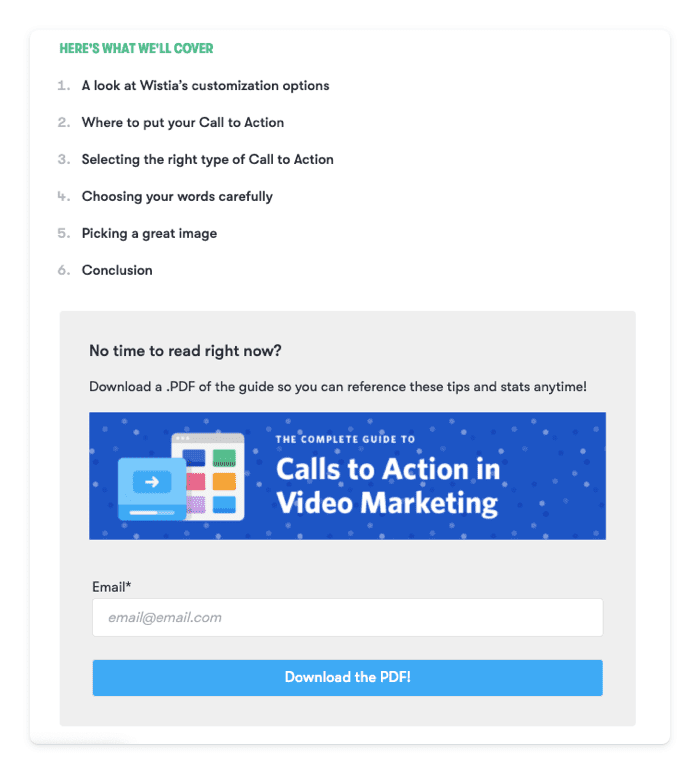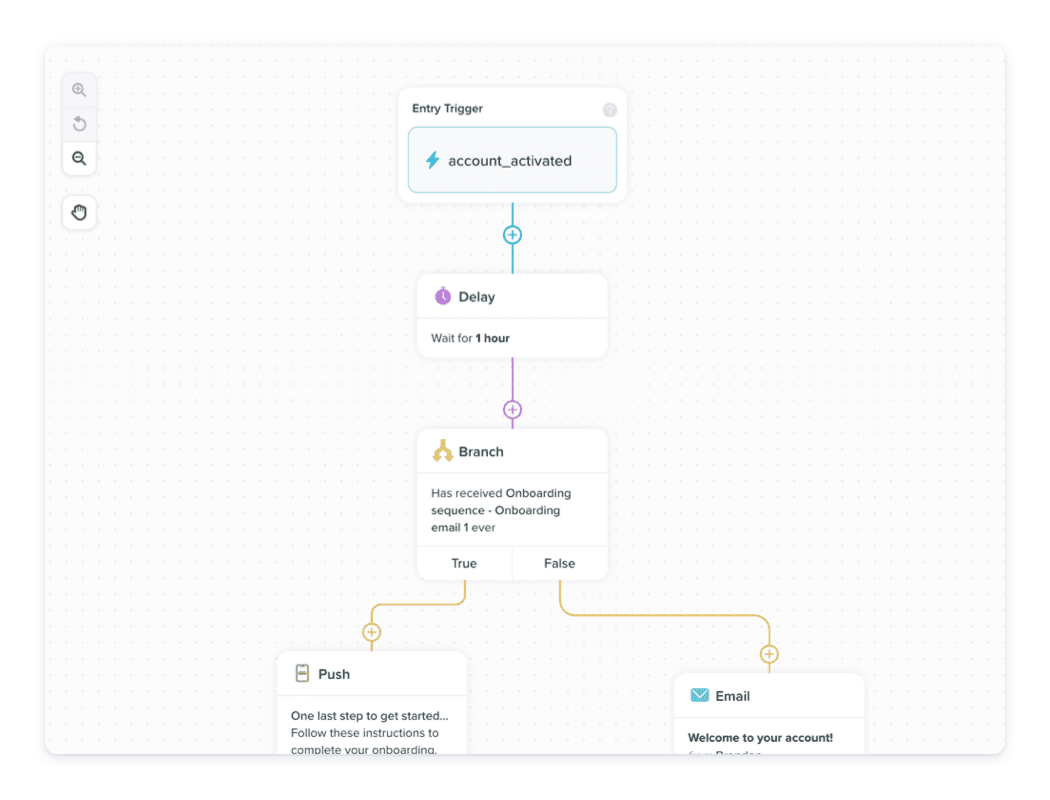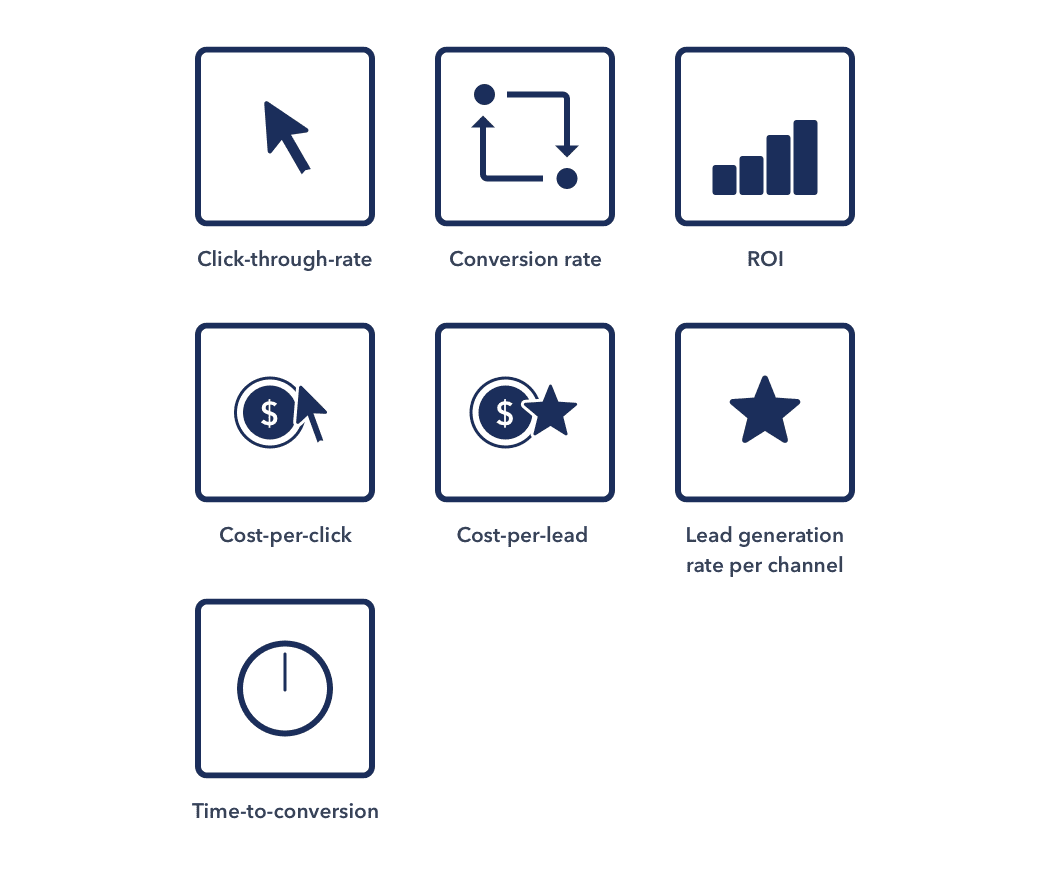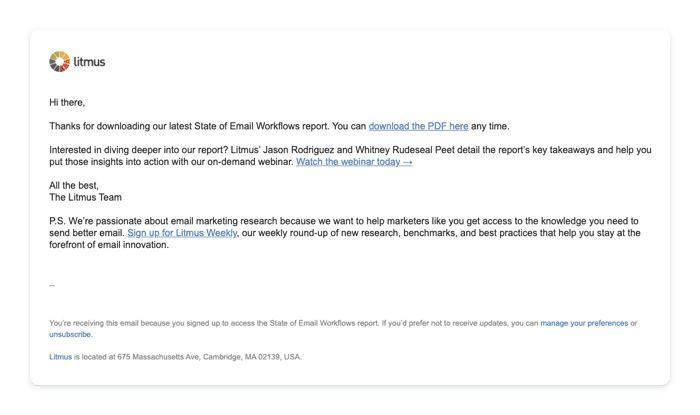
Lead generation strategies: What you need to know
-
Messaging and AutomationUpdatedPosted:
On this page
This isn’t your first marketing rodeo, and you’re no stranger to lead generation strategies. Everyone can use a refresher now and then, though.
We’re going to dive into the lead generation funnel, which metrics you should be tracking, and actionable tips you can start using today. Let’s get started!
The lead generation funnel
As with many marketing strategies, if you asked multiple marketers about the stages of the lead generation funnel, you could get different answers. Some teams like to opt for a simple three-stage funnel, while other funnel examples could have as many as seven steps.
We believe in starting simple and adding more stages if it suits your business and sales process. Here are the three main steps of lead generation.

Top of the funnel (TOFU)
The top of your marketing funnel focuses on driving awareness and traffic to your company. While quality usually beats quantity at every marketing stage, you’ll cast your widest net at the top of the funnel. You’ll also use content to educate your new audience.
Tactics or channels you could use:
- Social media
- Podcasts
- Content marketing
- SEM / Paid ads
- Lead magnets
Middle of the funnel (MOFU)
In the middle of the marketing funnel, you’re beginning to pull potential leads from your general audience. People will opt-in to receive more information or resources, and you’ll work to build the relationship.
Tactics or channels you could use:
- Lead capture forms
- Drip email campaigns
- Webinars
- Push notifications
At this stage, there are two classifications that leads could fall into—marketing qualified leads and sales qualified leads.
Marketing qualified leads (MQLs) are people that could eventually turn into a customer. For example, when a person (on a lead nurture email sequence) signed up for a webinar about a specific problem or indicated their role in a company.
Sales qualified leads (SQLs) have gone through another step of analysis by the sales team. If a lead meets the sales team’s criteria, they could be directly approached for a sales call or demo.
Bottom of the funnel (BOFU)
When leads sign up for demos and free trials or begin the process to make their first purchase, they’ve reached the bottom of the funnel. This stage is the final push from “prospect” to “customer.”
Tactics or channels you could use:
- Demos
- Free trials
- Consultations
- Live chat + chat bots
At the bottom of the funnel, leads will be classified as conversation ready leads (CRLs). A person shows that they’re ready to explore options with your company when they initiate a live chat or request a demo or call.
Conversation ready leads are the most likely to convert, since they’re expressing direct interest in the product.
When does the sales team get involved?
Now that we’ve covered the three basic phases of the lead generation funnel, it’s time to talk sales. Each company handles qualifying leads and sales involvement differently, so your funnel may have extra or shifted steps.
For example, your parameters for defining a marketing qualified lead vs. a sales qualified lead could be different. If you use a lead scoring system, you’ll need additional checkpoints, even just internal ones, to move people along the funnel.

Communication is key if you want to seamlessly pass leads to sales and work as a cohesive team. Collaborate with the sales team on understanding the customer journey, and what information and actions both marketing and sales need to do their best work.
4 elements your lead generation strategies need
Similar to how your lead generation funnel phases can be simple or complex, so can your strategy and lead generation tactics. Advanced automation and segmentation may make your lead gen strategy more complicated, but at its core, it needs these four elements.
Lead magnets (TOFU)
The first lead generation example we’ll explore are lead magnets. If you haven’t created lead magnets yourself, chances are you’ve at least downloaded a few. In addition to creating the lead magnet itself, you’ll need a lead capture page to collect signups.
Some common lead magnet formats include:
- Ebooks
- Reports
- Content upgrades
- Interactive tools
- Templates
- Video courses
- Resource guides
- Swipe files
- Quizzes
- Webinars
The goal of lead magnets is to exchange value for a prospect’s email address so that you can move into a “lead nurture phase.” If you want to deliver a worthwhile lead magnet, it needs to be:
- Immediately valuable. Back theory up with small, actionable tips.
- Specific. You can do a deep dive on a topic, but keep your scope focused. A lead magnet meant for everyone is perfect for no one.
- Ideally, evergreen. The best-case scenario is that your content is so valuable that people return to it repeatedly. At the very least, choose a topic that doesn’t require constant updating.
Now let’s look at some high-quality examples. First is the ebook, The 3 Pillars of Email Marketing from Litmus. The book is immediately valuable since it covers specific steps to improving your email process.
While email in itself is a broad topic, the lead magnet manages to be more specific by: focusing on improving your email marketing, not learning to design emails, choosing a service provider, and measuring performance.
The content is also evergreen since high-level best practices
aren’t likely to change every few months. Finally, the landing
page covers essential details such as what you’ll learn in the
ebook, and what results you can expect from implementing the
lessons.

Rather than tackling the entire topic of video marketing, the content narrows in on a single element.

If you want to reference it later, you can simply enter your email address to get a PDF version.
There are two potential benefits to this method. First, Wistia can take advantage of the work they put into creating the content by gaining organic SEO traffic from the ungated blog post. Having an optional opt-in may also begin to filter out more serious video marketers, who could be a better fit down the line.
Lead nurture (MOFU)
So you’ve collected a new lead’s email address—now what? Once you’ve established the initial touchpoint with a prospect, it’s time to use tactics such as email marketing to nurture the relationship.
Some of the things your lead nurture emails should accomplish:
- Educating new leads on their problem and potential solutions
- Explaining the benefits of your solution
- Building trust and brand affinity
To kick off our examples, Code School sends resources for people who want to learn to code. You can use email to send related content or support after a prospect has downloaded your lead magnet.

If your prospects aren’t entirely sold on your solution or the importance of the product at hand, you can take an approach like Casper did. The email below has a few enticing stats about the state of sleepers along with a CTA to read more about the issue. Casper also takes the time to highlight their mission, which can help build a brand connection.

Our final lead nurture email example is from TrustedHousesitters. Every company has competition to grapple with and mental hurdles to help potential customers over. In TrustedHousesitters’ case, they know that a barrier to conversion is people feeling unsure about letting strangers into their homes.

Therefore, they used a lead nurture email to educate leads about the housesitting process from the perspective of actual customers.
Lead scoring (MOFU)
Lead scoring can benefit every company, no matter how hands-on or hands-off a sales team is in your process.To create a lead scoring model, first think about all of the actions a person might take leading up to conversion.
Example actions to use in your lead scoring include:
- Downloading a lead magnet
- Visiting a pricing page
- Opening emails
- Returning to your blog
- Searching for a topic on your site
- Attending a webinar
In addition to actions that an individual takes, information about them or their company may qualify them as a lead. For example, you may look out for:
- What size company they work for
- What their role is
- What demographic they fall into
- What marketing channel they found you through
Once you’ve determined the actions and information that can tell you about a prospect, you need to identify which are most valuable. To do this, you could analyze the demographics and actions of your current engaged users to find common themes.
Once you’ve chosen a few key lead scoring metrics, you can assign values to them. In the example lead scoring method below, visiting a pricing page is “worth” ten times as much as opening an email.

Once you’ve assigned values to actions, you can determine thresholds for qualification. For example, a lead with a score of seven within a month probably isn’t a priority for sales outreach. On the other hand, a user with a lead score of 35 within the model could be a good fit.
Conversion via landing pages (BOFU)
The final stop on a person’s trip down your lead generation funnel is a conversion via a landing page. As we mentioned above, conversion could be signing up for a demo or free trial, or requesting more information from a sales rep.
To increase your chances of success, aim to make your conversion landing page as easy to use as possible.
For example, all that’s needed to start a Vero free trial is your email address and password. Including a clear value proposition and social proof is also useful.
Building or improving your lead generation workflow
You’ve seen examples of other company’s lead generation strategies, and now it’s time to create a workflow of your own. Use the following five steps to develop or improve your lead generation workflow.
Choose a customer persona or a job-to-be-done
First and foremost, you need to determine who you’ll be targeting with your lead generation workflow. The clearer you can get on the type of customer you want to attract and what they want to accomplish, the easier it will be to create relevant marketing.
Looking at your existing email segmentation is a good starting point. If there are user personas or niches that you’re already customizing content for, they’re likely an important audience. For example, Vero has email segments targeted at developers, which means leads in this audience are useful.
 Questions to ask yourself:
Questions to ask yourself:
- Is there a particular type of user who is the best fit or most profitable fit?
- Is there a demographic or business case that would align with current company-wide goals?
- What goals does this persona have? What challenges are they facing? What apprehensions do they have about using us?
Audit your current lead generation strategies
Next, you’ll take a look at your current efforts. By auditing what materials you already have and how they’re performing, you can save time and effort by reusing what already works. Or, you can identify gaps where new material is needed.
Here are some questions to ask yourself:
- What lead generation channels are we already using? Which are the most successful?
- Do we already have lead magnets? If so, how do they perform? If not, what topics or formats would benefit the target persona?
- What has and hasn’t worked to attract customers in the past?
- Do we have any materials that we can reuse or update?
Choose your methods
At this point in the process, you’ll nail down the exact lead magnets and tactics you’ll use in your lead generation strategies. A recent GetResponse study found that companies in different industries and growth stages prefer various types of lead magnets.


For example, B2B companies are equally drawn to video and written content, while ecommerce brands saw the highest conversions from video and interactive tools.
Here are some questions to ask yourself:
- What type of lead magnet will you create?
- What topic will your lead magnet be?
- How will you drive traffic to your lead magnet?
- What will your lead nurture emails cover?
- When and how will leads be passed onto the sales team (if applicable)?
Choose tools and assign tasks
Planning for implementation before you get started helps everyone understand their role in the project. Choosing tools before you get started also lets you know where you may need addenda capabilities before you get into the middle of the project.
Here are some questions to ask yourself:
- Who are the stakeholders on this project?
- How will we measure success, and what are our goals?
- What tools do you have or need to get to collect leads, create magnets, or automate email sequences?
Below is an example of an automated email sequence (workflow) in Vero.

Assess results
Once you’ve strategized, created, and launched your lead generation funnel, it’s time to assess your results.
Here are some questions to ask yourself:
- How are the new channels and tactics converting?
- Are results changing over time, signaling a change in relevancy or fit?
- Is the funnel driving quality leads?
- How well do leads from these tactics retain long-term?
Lead generation KPIs to monitor
How you “feel” a campaign performed doesn’t mean much to other leaders, so we’ve got you covered with key lead generation metrics to report.

Click-through-rate
Your click-through-rate is the top of the funnel metric to establish what percentage of people wanted to investigate your lead magnet further. You’ll also use CTR for your lead nurture emails to test the effectiveness of areas such as your subject line and preview text.
Click-through-rate = (number of clicks / number of impressions) * 100
GetResponse lists the average click-through-rate on a triggered email as 10.39%. It’s always a good idea to compare your current performance to your past performance, too.

Conversion rate
On the opposite end of your lead generation funnel is the conversion rate. Ideally, a large percentage of people who enter your funnel via a method such as a lead magnet end up converting.After all, the higher the conversion rate, the fewer people you need to get in front of to hit your goals.
Conversion rate = (Number of converted customers / total number of leads) * 100
ROI
Return on investment is the ultimate “is it worth it?” measurement. To calculate it, you’ll need to know how much you’re investing in your lead generation strategies, and how much customer value they’re delivering.Measuring ROI can be tricky, especially if you’re using organic traffic over paid efforts.
To get a grasp on the cost of lead generation, your team could track the time invested in conversion efforts.
ROI = (Amount gained – amount spent / amount spent) * 100
According to Litmus, 70% of brands can’t measure email ROI well. If you want to learn more about email ROI, check out our sample calculation in our roundup of essential email analytics.

Cost per click
If you’re using paid acquisition methods, such as social ads or search engine marketing, you should track your costs per click. Having this top of the funnel metric empowers you to compare performance along the marketing funnel.If you were to only focus on the end goal of conversions, you’d have no idea where to focus improvements if your results weren’t up to par.
Cost per click = (Total spent / Total number of clicks) * 100
The average Google AdWords cost per click across all industries is $2.69, but it’s always useful to find benchmarks for your niche. Costs also vary by platform, with the average global cost per click on Facebook coming in at just $0.35.

Cost per lead
Moving a little further into the lead gen funnel, you can calculate your cost per lead. While CPC measures the cost of “eyeballs” on a page, your cost per lead lets you know how much to spend to get someone into your lead nurturing process.When you calculate your cost per lead, you can compare it to customer value to make sure a funnel is still profitable.
Keep in mind that many factors contribute to your total dollars spent. In addition to direct marketing costs such as paids ads, you need to consider the work that goes into a campaign.Cost per lead = (Total spent / Total number of leads) * 100
The hours an employee spends on marketing as well as any tools they use to create the resource should all be considered.
Lead gen rate per channel
If you’re using multiple channels to attract leads, you should be tracking the effectiveness of each. That way, you can double-down your efforts on high-performing channels and cut investments to under-performing ones.
Lead gen rate per channel = (Total leads from channel / total impressions from channel) * 100
Some channels, such as content marketing, come with their own metrics. Here are a few content KPIs to gauge lead gen channel effectiveness:
- Social shares
- Time on page
- Bounce rate
- Lead quality
The Content Marketing Institute shared the handy graphic below on the metrics to track across content types.

Time-to-conversion
Each industry and company has its own sales cycle, but you may have a goal of decreasing time-to-conversion with your funnel.By using automated resources such as email campaigns and lead magnets, you may be able to engage and convert visitors in less time and with less one-on-one sales assistance.
Lead generation strategies best practices
Ready for a speed round of lead generation tips? Here goes:
-
Segment your lead generation funnels. Creating lead magnets and
lead nurture emails for different
audience segments
helps you deliver more relevant and impactful experiences. The
more you know about your targeted customer persona, the better.

- Create lead magnets that are actionable. When it comes to content, bigger isn’t always better. Strategy paired with actionable tips or resources is more helpful than a 10,000-word ebook filled with theory alone.
-
Set up immediate engagement. When a person signs up to receive a
lead magnet, they should receive it immediately. You should also
have a lead nurture email sequence set up. A simple text email
like this one from Litmus gives readers immediate access, and
also introduces related content.
 Leverage CRM software. If leads are passed between marketing and
sales, you need an organized way to track information. Using a
CRM can help you monitor leads and make sure every team has the
data they need.
Leverage CRM software. If leads are passed between marketing and
sales, you need an organized way to track information. Using a
CRM can help you monitor leads and make sure every team has the
data they need.
- Use lead nurture campaigns to build credibility and trust. The lead nurture period is all about convincing prospects that you’re the right choice. Use tactics such as case studies and social proof to build trust and answer any concerns they have. Litmus follows up with leads by sending content about the impact of email.
- Use what works. Do you have a blog post that already receives a lot of organic traffic and engagement? That’s the perfect place to add a lead magnet. Look at what your audience is already engaging with and repurpose work where possible.
Looking at all of the effort and strategy that goes into lead generation can be overwhelming. At the end of the day, lead generation success comes down to providing consistent, relevant value to your audience.
Want to learn more about organizing your marketing efforts to boost effectiveness? Check out our guide to lifecycle marketing here.


